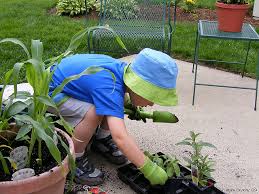Growing a Family Garden
Some of the most vivid memories of my childhood are traipsing through the vegetable garden with my parents, collecting buckets full of green beans, yellow squash, tomatoes, and other fresh vegetables. I remember sitting beside my great grandmother on our screened porch in the heat of summertime. We snapped beans, which would ultimately be canned in Mason jars and eaten during the winter months.
Planting a garden never became an interest of my own, but there is a phone call I love to receive in the summers. My neighbors graciously share their bounty of yellow squash, zucchini, and tomatoes with my family. Zucchini chocolate chip muffins and fresh salsa are a couple of my favorite recipes.
Even though the ground is cold and hard now in the midst of winter, I am dreaming of this summer’s fresh homegrown vegetables. And, as it turns out, now is the time to start planning if you are a first-time gardener.
You need to decide what you want to grow and how much space you need first. There is a neat online garden planner at almanac.com that allows you to draw your vegetable beds and tinker with the layout of various plants. The site also features a detailed chart providing information about when to start seeds indoors, when to move plants outdoors, and when to fertilize, The chart includes everything from asparagus to zucchini.
Bob and Sara Dow, my southwest Roanoke County neighbors, started their first garden a decade ago with about 20 tomato plants. By last summer their plot had grown, stretching about 12-feet by 18-feet and containing 10 different varieties of tomatoes. Sara Dow said she and her husband have grown peppers and broccoli with fair success, but have fared better with cucumbers, cherry tomatoes, and winter squash over the years.
The couple’s advice is to start small, with three or four plants of whatever vegetables your family prefers. As a beginning gardener, it may be easy to become overenthusiastic and plant more than you need, which could lead to wasted food. Consider how much your family will eat when you are planning.
When choosing a site for your garden, there are three important factors to consider: sunlight, water, and soil. Most vegetable plants need six to eight hours of full sunlight for maximum production. You will want your garden to be accessible to a water source, so that it is convenient for you to water the plants during dry conditions. Lastly, you want to choose an area with good soil. (More about that later.)
Gardeners have the option of buying vegetable plants that are ready to transplant directly into the garden or growing their own plants indoors from seeds. The Dows look for carefully chosen plants, usually shopping at a garden center or nursery.
“Buy well-developed plants, at least 8 to 10 inches tall with a strong stalk,” Bob Dow said.
The couple said it is important to leave plenty of room between plants so you can move around easily and pull weeds. About 18 inches between rows is standard.
“We have begun to use landscaping paper all over the ground, overlapping rows by about 10 inches,” Sara Dow said. “We pin it with landscaping pins, and — no more weeding!”
The work for the Dows will begin in March, when the couple begin to loosen the soil with a tiller and fertilize their plot. Then in mid-April, the couple will plant, but with the threat of frost still a possibility, Sara Dow said they often have to cover the plants at night.
“But the reward is that we have tomatoes by mid-June,” she said.
In 2013, the last spring frost in Roanoke was April 13, according to Farmer’s Almanac. A light freeze, which ranges from 29 to 32 degrees Fahrenheit, is likely to harm tender plants. But lower freezing temperatures will bring more widespread damage. Temperatures below 24 degrees Fahrenheit are most destructive.
Deer and other wildlife present a challenge to the Dows’ garden’s yield. The perimeter of their garden is staked with six-foot poles and covered in nylon netting to keep out deer. But when the tomato plants grow taller than the netted barrier, deer have been known to eat what can be reached over the top. The Dows also planted marigolds around the perimeter last year to discourage insects from snacking in the garden.
“It’s a lot of work and can get expensive, but we enjoy it and sharing with friends and neighbors,” said Sara Dow.
Gardening can be a costly venture, but there are several money-saving tricks that can be implemented:
Use empty food containers, such as plastic tubs or soda bottles, in which you can start to grow seeds. Poke holes in the bottom for drainage, and fill with potting soil.
Collecting your family’s fruit and vegetable scraps, egg shells, and some paper in a compost bin is win-win. You are sending less garbage to the landfill and you are generating free fertilizer for your garden.
Collect rainwater in five-gallon buckets to water your garden rather than using your hose and racking up a hefty utility bill.
Use discarded household items, such as bed frames, trellises, or railing as stakes for climbing plants, such as tomatoes, cucumbers, and pole beans.
Search for local gardening clubs or online forums where you can exchange information and swap seeds.
Vegetable gardening, if done efficiently, can pay off. According to Better Homes and Gardens Web site, a $2 tomato plant can provide you with 10 pounds of fruit in a season.
Eating healthy
Tim Summers, a teacher at Roanoke County’s Oak Grove Elementary School, grows much of his family’s food on a one-third-acre plot on the family’s seven-acre homestead in the Catawba Valley area of Botetourt County.
“We grow enough onions, garlic, winter squash, pumpkins and tomatoes that we don’t need to buy these during the year at all,” Summers said.
In addition to common vegetables, Summers grows many Asian varieties and Italian chicories — types you won’t likely find in our local grocery stores. He also harvests several types of fruit trees, blueberries and blackberries, and keeps bees and chickens. Summers practices only organic growing methods, and he raises all his plants from seeds. He does not use any gas-powered machines in the garden; he relies only on hand tools.
Eating healthy has long been a priority for Summers and his family, who are vegetarians. His young adult children, ages 19 and 22 years, have never eaten meat, he said. Summers’ began his garden more than 25 years ago.
“We do a lot of preserving and I normally grow 12 months of the year with my winter garden under greenhouse plastic tunnels and cold frame,” he said.
Summers said his best advice to beginners is to care for your soil first to minimize all pest and disease problems in the garden. Plants need the proper balance of nitrogen, phosphorus, and potassium to thrive. Ph balance is important too, as most plants need nearly neutral pH.
“A soil test can determine if anything is out of whack,” Summers said. “If so, amendments can be added to correct imbalances.”
Summers notes the importance of compost in organic gardening.
“Well-made compost should add a good balance of all essential nutrients to your soil,” he said.
Soil testing is one of the services provided by the Virginia Cooperative Extension. The local office that serves Roanoke, Roanoke County and Salem, which is located at 3738 Brambleton Avenue in Roanoke, offers a walk-in diagnostic clinic weekdays from 8:30 a.m. to 4:30 p.m. The Extension office also mans a horticulture hotline, which can be reached by phoning (540) 776-7178. There are also at-home tests, which can be purchased in retail stores, that provide immediate analyses.
Involving children
There are many ways to make growing vegetables fun for the entire family. Summers suggests giving kids a plot of their own to plant and maintain, which will allow them to work alongside parents in the garden. Children can also plant seed and care for seedlings indoors.
“Plant things that they can pick and eat raw,” he said. “I used to be able to tell where my kids were because I could hear them crunching sugar snap peas.”
In Summers’ experience, children seem more likely to eat fresh vegetables they have had a hand in growing. Research supports that conclusion.
“Children [also] develop an appreciation for nature and science, the delicate balance of life,” Summers said.
A good way to start gardening on a smaller scale and to involve children is to plant a few themed raised garden beds. Interesting garden themes include pizza, herbs, and sensory.
My favorite is the pizza garden, which may include many of the ingredients you need to make pizza sauce, such as basil, oregano, garlic, tomatoes, green peppers, and onions. You can even design the garden in the shape of a circle divided into wedges to look like a pizza.
The Colonial herb garden is a nice link to the Virginia studies Standards of Learning because it contains many of the herbs that likely would have been grown by our state’s earliest Jamestown settlers. Culinary herbs, such as lavender, thyme, sage, and rosemary are recommended for this type of garden.
A sensory garden may appeal most to preschool-age children because it is based on the five senses. This type of garden can contain as few as five plants (one for each sense), or several varieties in each of the sense categories. Suggested plants include Lamb’s ears for touch, strawberries or mint to taste, lemon balm for scent, blue false indigo with its rattling seed pods for sound, and a bright-colored flower, such as zinnia, for sight.
Kid-sized hand tools and gardening gloves may encourage children to help out in the garden. Adults should take care of the heavy work, such as tilling and prepping the soil. Let the children choose from plants that are easy to grow: radishes, squash, tomatoes, lettuce, peas, and beans.
Children can also repurpose or recycle items to create decorations or tools for the garden. Plant and herb markers can be crafted from household items, such wine corks and wooden skewers or wooden clothespins. Planters and flower pots can be painted or redesigned with bright colors of the child’s choosing to add to the garden’s decor.
There are educational activities too. Children can keep a log that measures the growth of the plants. Older children can use the Internet to research about pests and other gardening topics. There even are gardening apps that tech-savvy kids can download to smartphones and iPods. The trick is to find the balance of work, fun, and education when it comes to involving children in the garden. If they have a hand in growing them, then children are more likely to eat the vegetables from your garden.
A 2009 study by researchers at Ohio State University found that just more than 20 percent of children ages two to five years meet the government’s recommended daily guideline for vegetable consumption. As if that statistic is not dour enough, the percentage declines more as children get older. That same study concluded that only about one in 10 of the adolescents surveyed consumed the recommended daily value of vegetables.
The study surveyed more than 6,000 children and adolescents. Researchers found that about one-third of the vegetables these kids consumed was fried potatoes, and a little more than one-third of their fruit intake came from sugary juices.
Encouraging children to take a role in planning meals can prompt healthier lifestyle habits. Gardening is a fun, interactive way to promote involvement among the entire family.





